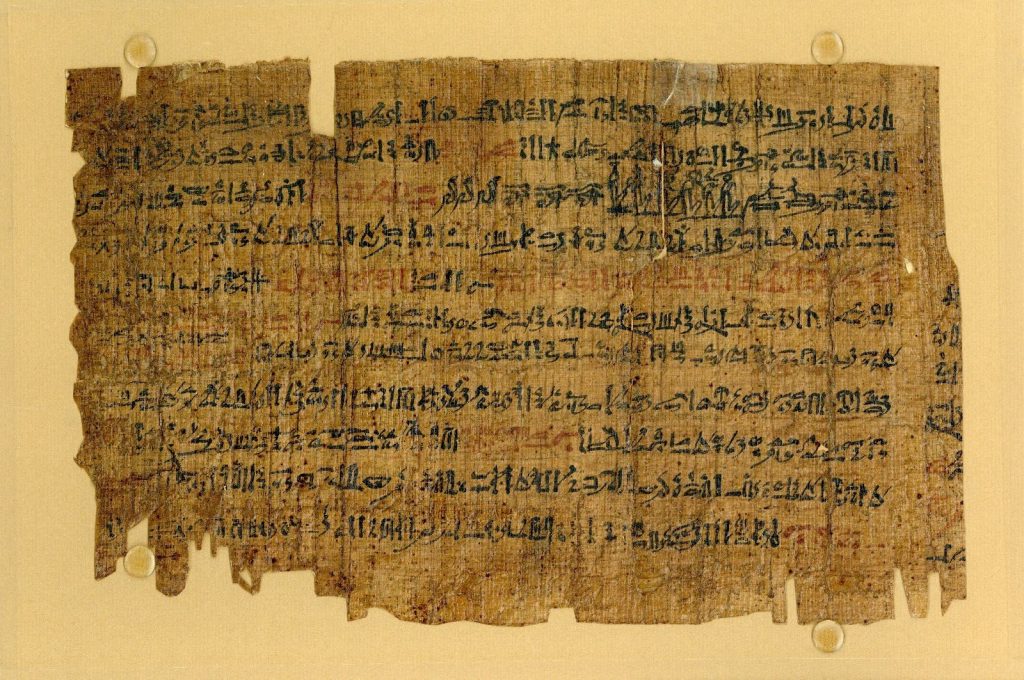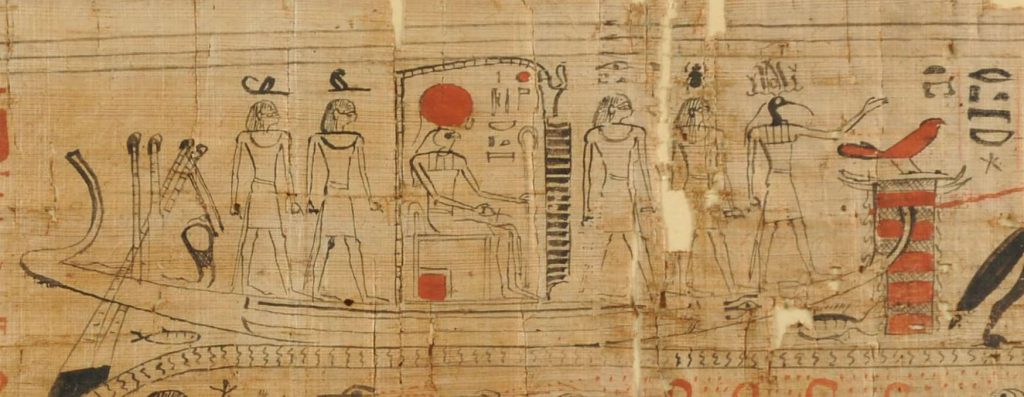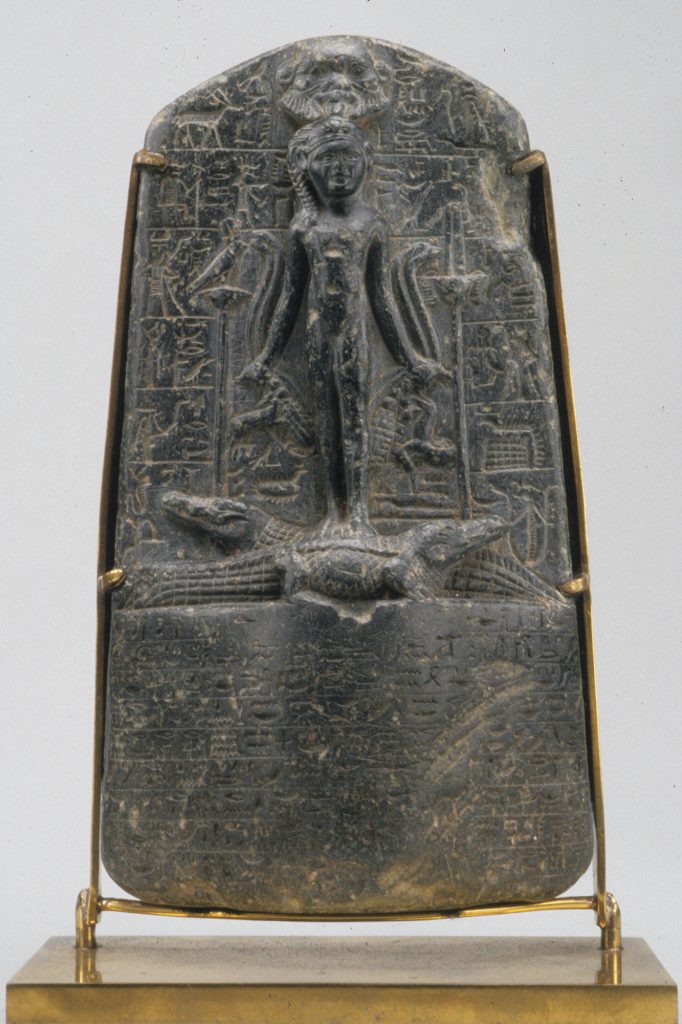
In this series we’re discussing charms – spells in the form of short stories which mirror and resolve problems in the real world. In the first post of this series we discussed a text from an eighth-century CE manuscript which, although from a Christian context, contained a story in which the Egyptian god Horus eats a bird which is mysteriously three birds at the same time, and has a stomach ache which is healed by his mother Isis.
As we mentioned, this Coptic text has a very close parallel in a much older Egyptian charm, which is the subject of this post. Leiden I 348 is a roll 360 cm long, dating to the reign of Ramesses II (1279-1213 BCE) or shortly thereafter, written by five different scribes. It was purchased by the 19th-century trader and consul Jean d’Anastasy, or his agents, in the area of Memphis in the early 1820s, and sold to the Dutch National Museum of Antiquities in 1828. Maarten Raven suspects that it was probably found in Saqqara, the vast necropolis of Memphis, home to the most famous pyramids as well as many other tombs and temples, and that it may belong to a small magical archive, along with four other texts purchased in Memphis from the same sale.
Along with a series of writing exercises, the manuscript contains 33 charms, written in Middle Egyptian in the hieratic script, a cursive form of hieroglyphs, in black and red ink. These charms are intended to deal with problems such as burns, difficult childbirth, and – most often – stomach ache, the subject of formula 23, which interests us here:
“My belly! My belly!” cried Horus.
“What is it?” asked Isis.
Horus said, “I have eaten the golden abdju-fish on the border of the pure pool of Re!”
Isis said, “Is it he who ate the golden abdju-fish on the border of the pure pool of Re? Does he lie awake suffering in his belly? Do the Little Ennead weep because of the suffering of his belly, the Unwearying Souls?”
This formula is to be spoken and written on a new dish in yellow ochre, anointed with honey; wash the man who suffers in his belly.
𓃣𓃣𓁜𓁜𓁟𓁚𓁥𓁦𓂀𓂀𓂀𓆗𓆗𓆗
Leiden I 348, formula 23, recto col. 12 l.11- col. 13 l.3
Though much shorter than the Coptic example, this charm follows a very similar structure. Horus cries out, suffering from stomach ache, and his mother Isis asks what is wrong. He confesses that he has eaten the golden abdju-fish from the pool of Re, the sun god.

This abjdu was probably a real fish, although it has not yet been identified. Its mythological role, however, was to swim through the heavenly waters ahead of the barque of the sun god, and warn of the approach of his enemy, the serpent Apep. Eating an abjdu was forbidden during certain festivals, and in another text it is a sacrilegious act attributed to the dangerous god Seth. By eating it, therefore, Horus has committed a transgression, resulting in his stomach ache.
Isis’ response doesn’t seem immediately helpful – she says, through a rhetorical question, that a group of gods called the “Little Ennead” and the “Unwearying Souls” are weeping because of Horus’ suffering. The identity of the “Little Ennead” varies depending on the context, but the Unwearying Souls are likely a reference to a group of stars in the southern sky, who, like the abdju-fish, at times accompanied the barque of the sun god. The purpose of this charm, then, is to identify the suffering of a real person – perhaps a child – with the suffering of the god Horus. Just as the star-gods weep for Horus, they are to weep for the suffering child, and heal the stomach ache.
Although the details are different, then, the structure of the Coptic charm and this one, which is about two thousand years older, are identical. Horus has eaten an animal which he probably shouldn’t have – a bird in one case, a fish in the other – and his stomach aches. He cries out for Isis, who responds by speaking a spell which will heal him, and, by extension, the suffering patient. The Ramesside version includes one detail missing from the Coptic example – that the formula is supposed to be spoken over a written version of the same formula inscribed on a dish, which is filled with honey, and perhaps other liquids, and used to anoint the patient’s belly. Not Similar rituals are mentioned in other Coptic magical texts, so it is possible that even though the instructions weren’t included in the text, the person reading it was supposed to know that the charm should be spoken over a liquid which would then be used to anoint the sufferer. The text is followed by a sequence of 14 hieroglyphs, which we have rendered (imperfectly) in unicode above. These were perhaps to be copied onto the bowl too, or else used to create a papyrus amulet, of which many examples survive.

These two charms are part of a much larger tradition, whose earliest examples date to Egypt’s Middle Kingdom (ca. 2055-1650 BCE), while the latest written versions known to us date to the tenth or eleventh century CE. Like the two discussed here, most begin with a young god in trouble calling out for help to a parent; usually the characters are Horus and Isis, but there are other variations – Bast or Isis calling out to Re, for example. And although the two instances we have looked at here are for use against stomach ache, others deal with problems such as scorpion stings, headache, difficult childbirth, fever; one group of Coptic examples are actually love spells.
The fact that this tradition survived for so many thousands of years, even after the traditional temples and their cults had ceased to function, and most (if not all) Egyptians had converted to Christianity, is a testament to their importance as a healing tradition. Similar examples of pre-Christian deities appearing in charms even after Christianisation are known from other cultures, but Egypt’s long written history allows us to trace its development in detail. These charms have been much studied over the last few centuries by scholars interested in the survival of Pharaonic culture after Christianisation – this is not surprising, perhaps, given the splendour of the material culture left behind by the Pharaohs, and the fascination it exerts on modern people. The charms represent a more quotidian version of that same culture, but we should note that they are not simply survivals which had endured unchanged over time. They had to be actively transmitted – learned, copied, and practiced – in each generation. Over time, therefore, they were remoulded by the changing needs and worldview of the people who used them. We noted in our last post that Isis’ spell called upon Jesus, and that Horus uses messenger demons probably named after the Christian villain Herod Agrippa. In the next posts in this series, we’ll explore how the Coptic charms adapted and transformed this millennia-old tradition in completely new and fascinating ways.
Bibliography and Further Reading
Borghouts, Joris F. Ancient Egyptian Magical Texts. Leiden, 1978.
A collection of Pharaonic magical texts; the one discussed here is published as number 49.
Borghouts, Joris F. The Magical Texts of Papyrus Leiden I 348. Leiden, 1971.
The most accessible publication of the papyrus discussed here; the formula here is on p. 26.
Blumell, Lincoln, and Korshi Dosoo. “Horus, Isis, and the Dark-Eyed Beauty. A Series of Magical Ostraca in the Brigham Young University Collection.” Archiv für Papyrusforchung 64 (2018): 199–259. URL
Frankfurter, David. “The Laments of Horus in Coptic. Myth, Folklore, and Syncretism in Late Antique Egypt.” In Antike Mythen: Medien, Transformationen und Konstruktionen, edited by Ueli Dill and Christine Walde. Berlin: Walter de Gruyter, 2009, 229–251. URL
Gamer-Wallert, Ingrid. Fische und Fischekulte im Alten Ägypten (Wiesbaden: Otto Harrassowitz, 1970), pp. 27-29, 113-115, 131-132.
Hevesi, Krisztina. “A Few Remarks on the Persistence of Native Egyptian historiolae in Coptic Magical Texts”. In Current Research in Egyptology 2018: Proceedings of the Nineteenth Annual Symposium, Czech Institute of Egyptology, Faculty of Arts, Charles University, Prague, 25-28 June 2018, edited by Marie Peterková Hlouchová, Dana Belohoubková, Jirí Honzl and Vera Nováková. Oxford: Archaeopress Publishing, 2019, 42-54. [URL]
Raven, Maarten J. Egyptian Magic: The Quest for Thoth’s Book of Secrets. Cairo: American University in Cairo Press, 2012, pp. 78-82.
